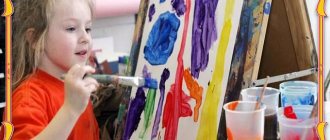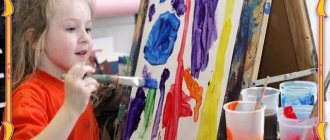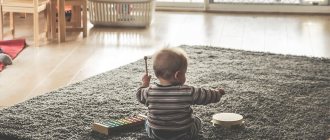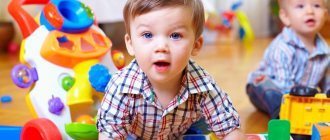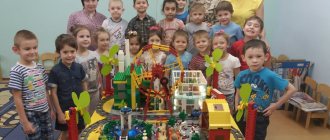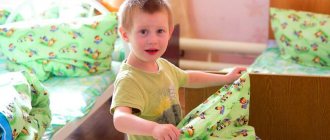Formation of aesthetic feelings in preschool age
Aesthetic education is not innate. It begins to form in early childhood in a social environment. Active and competent pedagogical leadership is critical to the development of aesthetic sensitivity. In the process of aesthetic development, children gradually master the basics of aesthetic culture, aesthetic perception, ideas, concepts, interests, judgments, needs, feelings, creativity and artistic activity. The dynamics of the formation of aesthetic sensitivity and the formation of aesthetic culture involves the passage of several stages directly related to the developmental characteristics of a child at a certain age.
It is advisable to consider the features of early childhood development as a propaedeutic period towards aesthetic acceptance of the surrounding world. This stage begins with the formation of sensory sensitivity and subsequent emotional “reaction” to acquaintance with the most striking qualities and characteristics of objects that surround the child. From early childhood he pays attention to everything beautiful, bright, colorful and shiny. Aesthetic perception of the environment has its own specific characteristics. For a child, the most important thing is the sensory form of things, namely their shape, color, sound, smell. Therefore, the aesthetic education of a child requires a certain level of development of sensory culture.
The child perceives beauty as the unity of content and form. Form is the unity of lines, sounds, colors. But an aesthetic child can perceive only when the perception is emotionally charged, because aesthetic appreciation is closely related to feelings and emotions. Aesthetic feelings are distinguished by the fact that they are accompanied by an encounter with the beautiful light of spiritual excitement and selfless joy. Thus, we can conclude that an important component in the formation of aesthetic feelings is the emotional reaction to the perceived object. But the full formation of aesthetic feelings cannot occur with an abstract, “passive” perception of reality.
Activities in preschool age are also important for the formation and development of aesthetic feelings. At an early age, techniques for imitation of various types of primitive games and artistic activities are formed, and a feeling of satisfaction develops not so much from performing the activity, but from the achieved result.
The development of language contributes to the assimilation of the names of a much larger number of reference signs, aesthetic qualities through comparison: dirty - clean, small - big, sad - cheerful, ugly - beautiful, etc.
It is necessary to pay attention to the fact that in most cases preschoolers cannot separate the concepts of “correct” and “beautiful”, which has great potential for the implementation of both moral and aesthetic educational tasks. In preschool age, aesthetic education of children is carried out by parents “intuitively” rather than purposefully. But at the same time, aesthetic education in the family plays an important role in the aesthetic development of a preschool child and the formation of his personality, despite the fact that parents do not have pedagogical and methodological skills. In the family, family traditions are the basis of aesthetic education, ensuring continuity between generations, the formation of aesthetic values, role models and experience. Therefore, it is also important to carry out explanatory and methodological work with parents of preschool children on aesthetic education.
In the conditions of a preschool educational institution, subsequent changes occur in the aesthetic development of the child. The child becomes more receptive to certain elements of art form, such as color, rhythm and rhyme. Children also begin to react differently to the work itself. Their motivation to evaluate a work of art is secular or subjective. Young children usually notice individual features of a phenomenon, express their thoughts briefly and sometimes use very specific assessments.
We educate with art
To successfully organize the aesthetic education of a preschooler, you need to provide the necessary conditions:
- create a development environment
- organize interaction with nature and art
- organize creative activities.
The main difference between the aesthetic education of children is that they perceive reality with their senses. Preschoolers pay attention to shape, color, sound, and beauty is perceived in the unity of form and content. When a baby likes something, he experiences bright feelings, excitement, delight, and selfless joy. At the same time, a teacher or parent needs to be able to direct the child’s emotional response from ordinary perception to understanding the beautiful and forming his own opinion. This way you can begin to develop good aesthetic taste. With proper upbringing, a preschooler will learn not only to understand beauty, but also to see beauty in everyday life in nature, everyday life, work, and clothing.
It is important to introduce children to the best examples of children's literature, music, folk art and painting. This way, children will learn to recognize and love works of art that they understand.
Preschool children are capable of almost all types of creativity: they can draw, cut out, sculpt, glue, dance and sing, write stories and even rhyme. If a child shows interest in music, movements, images, speech and he wants to do something similar himself, he is ready for independent creative activity. By supporting your child and helping him create, you can develop the child’s ability to generate ideas and implement them.
In kindergarten there is every opportunity to instill in children a love of art:
- classes to develop visual arts and speech skills
- music lessons
- theatrical games
- thematic classes
- invitation of theater, circus and philharmonic artists
- holidays.
Objectives of aesthetic education of preschool children
Full and harmonious physical and intellectual development, a hierarchy of values, a moral assessment of reality and an active life position determine a comprehensively developed personality, the moral component of which depends primarily on aesthetic education. The kindergarten teacher must help children move from the perception of beauty and emotional reaction to objects of aesthetic feelings to understanding, to the formation of aesthetic concepts, opinions, ideas, assessments, to the formation of a scale of value relations. Aesthetic education is the painstaking work of the educator, which should be carried out unobtrusively and systematically in order to teach children to aesthetically perceive the world around them, experience it, change it, teach them to create a common system of aesthetic norms and experiences, which should become the basis of an aesthetic culture necessary for the harmonious development of the personality of a preschooler. , like all other personal qualities.
The goal of aesthetic education is to develop in children the ability to see the beauty of the life around them and create and transform it. Based on the goal, the tasks of aesthetic education can be divided into two groups.
The development of aesthetic perception, artistic and aesthetic skills, and activity is based on the development of sensory systems at the required time, the work of various analyzers capable of providing the necessary accuracy and subtlety of discrimination.
When performing aesthetic education tasks, children develop such personal qualities as initiative, anticipation of results, desire for them, and the ability to dream. Therefore, the first group of tasks is aimed at developing the aesthetic attitude of preschoolers to the surrounding reality. This group includes tasks that contribute to the development of aesthetic consciousness and perception of preschool children. The following tasks can be distinguished:
- Formation and development of sensory perception;
- Developing the ability to see, understand and feel the aesthetic beauty of nature, human actions and art.
- Familiarization with the system of reference qualities and personality traits, with the gradual inclusion of these names in the active dictionary of preschoolers;
- Give preschool children knowledge about beauty;
- The formation of aesthetic knowledge and judgments, ideas and concepts, which in turn determine aesthetic tastes and assessments, needs and interests;
- Formation and development of aesthetic emotions and feelings in preschool children: The ability to react emotionally to the beautiful and ugly, funny and sad, etc.
- Development of artistic taste, desire and need to study beauty.
Certain tasks require their solution using appropriate tools and methods. As A.S. believed Makarenko, methods are a means of influencing a person, ways by which a targeted pedagogical influence on the consciousness and behavior of students occurs. To complete the tasks of the first group, it is advisable to use methods such as observation, demonstration, example of an adult, and analysis.
The method of exposure is actually found in the first meeting and acquaintance with the subject of aesthetic reality. The teacher must think through the object of the demonstration and organize the lesson so that the children's attention is focused on what they see or hear. When implementing this group of methods, the teacher must be able to express his feeling, his attitude, he must be able to express his feelings in different ways, for example, expressiveness when reading a poetic work, sincere admiration for a beautiful thing or sincere disappointment from carelessness in clothing. The ability of an adult to clearly express his feelings and emotions is an active method of influencing a preschooler, since it is based on imitation of childhood.
Goals and objectives
The goal is to form an adequate aesthetic attitude towards the environment , to teach a little person to see and understand beauty. Education shapes perception, imagination, develops memory, feelings, interests, inclinations, and abilities. Helps to develop an active positive attitude towards everyday life.
Tasks:
- to form an idea of the values of the beautiful, beautiful, graceful, harmonious;
- to form a perception of beauty in art and everyday life;
- influence emotional responsiveness, empathy skills, sense of taste;
- lay the foundations of creativity and artistic education.
The result of education is:
- a general understanding of the good, the beautiful, the correct;
- perception of form, content;
- complicity, empathy;
- brightness of expression of emotions, impressions, imagination.
Read more: Contents, goals and objectives of aesthetic education.
Principles of aesthetic education
Aesthetic education of preschool children is carried out in accordance with the principles of modern pedagogy. Accordingly, aesthetic education, its forms, methods and means must correspond to the main goal - the education of a comprehensively developed, active, socially interested person, possessing not only the rudiments of aesthetic judgment and feeling, but also a high degree of aesthetic culture.
It is convenient to emphasize the basic principles underlying modern concepts of aesthetic education.
1) The principle of continuity
First of all, this is the principle of continuity of cultural components of aesthetic education of preschool children. This principle presupposes an inextricable connection between folk aesthetic culture, modern art and the best traditions of the past with the basic principles of aesthetic education.
2) The scientific principle
The scientific principle in aesthetic education should be based on a clear vision, analysis of what has been achieved, predictable results and a direct connection with goals that are significant to society. This principle implies the acquisition by the younger generation of strictly scientific knowledge in accordance with the characteristics of modern art and the stage of its development.
3) The principle of systematicity and programming
The principle under consideration assumes consistency and uniformity in the acquisition of knowledge, skills and aesthetic education in accordance with the age level of development and the use of content, forms and methods of teaching.
4) Principle of complexity
The principle of complexity of aesthetic education should be associated with the harmonious, holistic development of personality, which should be carried out in two directions. First, aesthetic development influences the formation of a child's personality and the development of certain aspects of personality, qualities and abilities. Secondly, the very formation of the personality of a preschool child has a significant impact on his system of values, views, norms and ideas, which at the same time have aesthetic properties.
5) Principle of unity
The principle of the unity of learning and development of the creative potential of preschool children assumes a close relationship between learning and the formation of independent artistic creativity in children. These processes are not considered separately, since creativity is formed in the process of acquiring knowledge, skills and abilities in education, and education brings great results when creative abilities are considered.
The interaction of the creative and educational components varies depending on the educational task: the less mastered the subject, the simpler the creative element; The better a subject is mastered, the wider the field of its combination with creative tasks.
The main way of aesthetic development of a preschool child is the development of his creativity and independent artistic activity. All the principles considered are closely related to each other and determine the direction and planning of the pedagogical process.
Cultivating an attitude towards beauty. When to start?
From an early age, young children are attracted to interesting, bright toys and objects. They evoke a feeling of joy, pronounced pleasure. The concept of beautiful begins to take shape. Playing, listening to fairy tales, looking at pictures of animals, children receive a lot of positive emotions. These emotions are the foundation for the formation of more complex qualities responsible for understanding beauty. The unconscious perception of beauty gradually moves to conscious harmonious taste and the development of creative abilities. The task of adults at this moment of development is to help the child and guide him in the right direction.
Each preschool institution has the potential to develop all the most important personality traits. A correctly constructed upbringing scheme with the assistance of the family guarantees the formation of a child as an aesthetically developed citizen of society.
Works of art are the most important means of education
Art is an inexhaustible tool for the moral and aesthetic education of preschool children. It teaches you to appreciate beauty, be kind, and sympathetic. The result of communication with masterpieces of world and national art is the spiritual enrichment of the child. Children are already exposed to many forms of artistic art: literature, painting, architecture, sculpture, cinema and theater. It is mandatory to use them in the educational process.
Works of art can be used both during classes, independent activities, and when decorating premises in a preschool institution. Works appropriate to their age are selected for different children. Illustrations from fairy tales, still lifes and landscapes, small works of sculpture (figurines made of wood, plaster), and various forms of decorative art are suitable. All events must be accompanied by music.
Aesthetics of everyday life is the first means of education
Cleanliness and order in a preschool institution is not only about maintaining sanitary and hygienic standards. This is an important part of education, helping the child himself to begin to realize the beauty of the world around him from an early age. There is a desire to take care of everything beautiful that he sees around him. Therefore, it is better to decorate all premises of the institution in a stylistically consistent line. In the groups of any kindergarten and other premises there must be drawings of other children, crafts, and works of folk art.
When decorating premises, it is advisable to remember the following principles:
- Practical justification of the situation;
- Maintaining cleanliness;
- Colourfulness;
- Contrast in design, necessary for the child to quickly find the element he likes;
- Combining all elements as a single ensemble.
Methods of education in preschool educational institutions
There are a huge number of methods for developing in children the right attitude towards beauty:
- General: persuasion, exercise, problem situations, use of emotional response;
- Methods of introduction to a specific type of art, depending on the direction of education;
- Methods of teaching artistic activity: introduction to techniques, sample, instructions, advice, self-assessment.
- Methods for developing creative abilities: problem-search methods.

